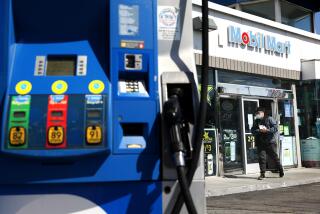Pressure Grows as Natural Gas Prices Plummet : Power: Output is way ahead of demand. Producers hope for better times with implementation of the Clean Air Act.
- Share via
NEW YORK — These are devastating times for people who produce natural gas, touted by many as the cheap, environmentally sound energy source of the future.
The problem for producers is that gas is too cheap, with prices at the lowest level since the 1960s. And prices are still falling, even though many in the industry have been giving up and shutting their wells.
The bleak short-term outlook for natural gas prices was underscored Wednesday when Columbia Gas System Inc. projected a $1-billion loss on its natural gas supply contracts. The Wilmington, Del., corporation said it could be forced into bankruptcy if banks refuse to restructure its credit lines.
Columbia is locked into contracts with suppliers that force it to pay up to four times the going rate for gas.
The average price for gas at the wellhead has fallen below $1.20 per 1,000 cubic feet, contrasted with about $2.40 in 1985, the year gas was deregulated.
Gas futures for July delivery closed Wednesday at the New York Mercantile Exchange at $1.215, their cheapest level since they began trading last year.
“Why are prices so low? There’s too much production and not enough market,” said Cary O’Reilly, associate editor of Natural Gas Week, an industry publication in Washington.
Gas was sold in the Rocky Mountain region for about 50 cents per 1,000 cubic feet, according to the weekly. That’s about a third the price some producers say they need to break even and a fourth of what they would like to see to make money.
Many in the industry believe that better times will come as the nation adopts the provisions of the Clean Air Act and tries to shake off some of its dependence on foreign oil. But for now, many gas producers can’t survive.
It’s hard to pinpoint an exact number of those who have been run out of business. But the Independent Petroleum Assn. of America, a group of small oil and gas producers that supplies about 60% of the U.S. supply of gas, said its membership rolls have fallen from about 10,000 to about 5,000 during the past decade.
The easiest culprit to blame for the recent price plunge is the warm winter weather the nation enjoyed, leaving companies that sell to consumers with plenty of gas on hand the past two summers. The recession also took a dent out of industrial uses.
Gas producers further complain of “below-cost dumping” by Canadian producers, accused by their U.S. counterparts of getting unfair government subsidies.
Sources in the industry point to other problems that limit the U.S. use of an energy source that is less than half the price of oil, with abundant supplies available in North America.
For one, the nation is not equipped to use all the gas on hand because of limited space available on the pipelines that transport gas and limited use of gas in vehicles. Fleet vehicles are starting to make increased use of gas, however, and a portion of President Bush’s energy strategy would cut through some of the regulatory hurdles to setting up new gas pipelines.
Some independent gas producers say they have been victimized by federal tax breaks given to those who produce natural gas from tight sand formations, geologic areas where gas does not flow easily, and from coal seams, where methane gas is present.
“Congress did a dumb thing that created part of the problem,” said Robert A. Hefner III, chairman of GHK Co., a gas producer based in Oklahoma City. “They basically handed a few billion dollars to maybe 10 companies. All the taxpayers are paying for it.”
The tax breaks were intended to increase use of that fuel to cut into the nation’s dependence on foreign crude oil.
More to Read
Inside the business of entertainment
The Wide Shot brings you news, analysis and insights on everything from streaming wars to production — and what it all means for the future.
You may occasionally receive promotional content from the Los Angeles Times.










